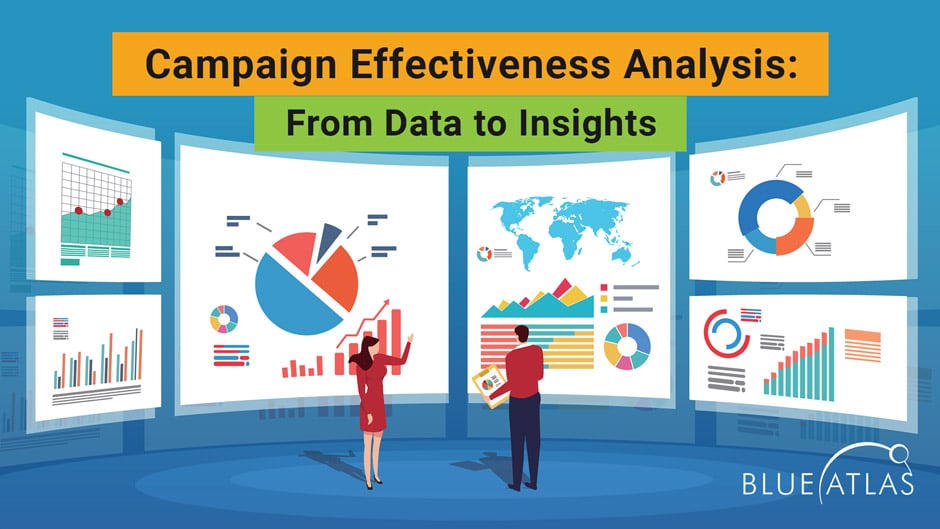Campaign Effectiveness Analysis: From Data to Actionable Insights

Campaign effectiveness analysis is not just a nice-to-have—it’s a must-have for any organization serious about enhancing its marketing strategy. It’s a vital process that turns the seemingly abstract world of data into tangible insights that can drive your marketing decisions.
Whether you’re launching a new product, promoting an existing service, or just trying to increase brand awareness, campaign effectiveness analysis helps measure the success of your marketing efforts. It allows you to understand what’s working and what isn’t and how to adjust your strategy accordingly. This invaluable feedback loop can mean the difference between a thriving campaign that resonates with your audience and one that falls flat.
Understanding Campaign Effectiveness Analysis
In this article, we’ll dive into campaign effectiveness analysis’s intricacies. We’ll start by defining the concept and highlighting its significance. Then, we’ll walk you through the process of identifying key metrics and converting raw data into meaningful insights. We’ll also shed light on how to leverage various tools and techniques for a comprehensive analysis, and how to present this data visually for ease of understanding.
As we progress, you’ll learn how to translate these insights into actionable strategies to shape future campaigns and the importance of integrating campaign analysis into your routine marketing practice. We’ll sprinkle in some applications and examples along the way to provide a practical perspective.
Demystifying Campaign Effectiveness Analysis
Campaign effectiveness analysis refers to the systematic examination of marketing campaign results with the goal of assessing the campaign’s impact and success. It involves identifying key metrics, collecting and analyzing relevant data, and interpreting these findings to extract meaningful insights. The results from this analysis then serve as a guide for making data-driven decisions and enhancing future marketing strategies.
At its core, campaign effectiveness analysis allows marketers to answer crucial questions like:
Did the campaign reach the intended audience?
How did the audience interact with the campaign?
Did the campaign lead to an increase in sales or website traffic?
Did it enhance brand awareness or engagement?
Essentially, it measures whether the campaign achieved its predefined objectives and how well it did so.
Why Campaign Effectiveness Analysis Matters
The importance of campaign effectiveness analysis cannot be overstated. In an era where data is abundant, making sense of this data can provide an edge for businesses. Without this analysis, you may be shooting in the dark, unsure if your marketing efforts are truly paying off.
- Firstly, campaign effectiveness analysis provides an understanding of your return on investment (ROI). It allows you to identify which campaigns are profitable and which ones may need reevaluating or even discarding. This saves time, resources, and energy, allowing your business to be more efficient and strategic in its marketing approach.
- Secondly, it delivers insights into customer behavior and preferences. By analyzing campaign performance, you can glean insights into what resonates with your audience, what drives them to take action, and how you can effectively engage them in future campaigns. This understanding can be a powerful tool in crafting targeted, relevant, and effective marketing campaigns that hit the mark.
- Finally, campaign effectiveness analysis fosters a culture of continuous learning and improvement. Each campaign presents an opportunity to learn, grow, and improve. Regularly analyzing campaign performance allows your business to evolve, innovate, and remain competitive in the ever-changing marketing landscape.
Identifying the Right Metrics
When it comes to campaign effectiveness analysis, not all metrics are created equal. There is a plethora of data available, and sifting through to find the most impactful metrics is a crucial step. These essential metrics—often referred to as Key Performance Indicators (KPIs)—can help you gauge your campaign’s success more accurately. They illuminate the path to actionable insights and strategic decision-making. Let’s delve into some of these pivotal metrics.
1) Reach
Reach measures the total number of unique individuals or households exposed to your campaign. This metric is vital in assessing the breadth of your campaign. It gives you a sense of how well your message is spreading across your intended audience. A broad reach, however, does not automatically guarantee success. It must be considered alongside other metrics to understand its real impact.
2) Impressions
Impressions are the total number of times your ad has been displayed, regardless of clicks or engagement. This metric is a reliable indicator of your campaign’s visibility. However, much like reach, impressions on their own don’t necessarily translate to a successful campaign. They must be coupled with other metrics to determine the quality of those impressions.
3) Click-Through Rate (CTR)
CTR is the percentage of people who clicked on your ad after seeing it. It’s calculated by dividing the number of clicks by the number of impressions. This metric is crucial in measuring the effectiveness of your ad copy and design. A high CTR indicates that your message resonates with your audience, compelling them to learn more.
4) Cost Per Click (CPC)
CPC measures how much you pay for each click in your pay-per-click (PPC) marketing campaigns. It’s calculated by dividing the total cost of your clicks by the number of those clicks. This metric helps to evaluate the cost-effectiveness of your digital advertising campaigns. A lower CPC indicates that you’re driving more traffic to your site without overspending.
5) Conversion Rate
Conversion rate measures the percentage of users who complete a desired action (such as making a purchase, filling out a form, or signing up for a newsletter) after clicking on your ad. This metric is one of the most critical indicators of campaign effectiveness. A high conversion rate means that your campaign is not only attracting the right audience but also successfully persuading them to take action.
6) Cost Per Lead (CPL)
CPL is a metric that calculates the cost of acquiring a new lead through your marketing efforts. It’s calculated by dividing the total cost spent on a campaign by the number of leads generated. This metric is particularly crucial for businesses with a lead generation model, which focuses on collecting information from potential customers for future follow-ups. A lower CPL signifies a more cost-effective campaign in generating potential business opportunities.
7) Cost per Acquisition (CPA)
CPA is the total cost of acquiring a new customer through a particular campaign or channel. It’s calculated by dividing the total campaign cost by the number of conversions. This metric is critical for understanding the financial effectiveness of your marketing efforts. A lower CPA signals a more cost-effective campaign.
8) Return on Ad Spend (ROAS)
ROAS is the revenue generated for each dollar spent on advertising. It’s a crucial profitability indicator that shows the monetary success of your campaign. A high ROAS denotes that your campaign is yielding profitable returns.
9) Customer Lifetime Value (CLV)
CLV measures the total revenue a business can reasonably expect from a single customer account throughout their relationship with the company. It’s a vital metric to consider in tandem with CPA and ROAS to get a clearer picture of long-term profitability.
In the world of campaign effectiveness analysis, understanding these metrics is just the starting point. Each of these metrics intertwines with the others to provide a comprehensive view of your campaign’s performance. By carefully selecting and monitoring the right KPIs, you can gain a deeper understanding of your marketing efforts, make data-driven decisions, and steer your campaigns toward success.
The Journey from Data to Insights
Turning Raw Data into Valuable Insights
Making sense of raw data can seem daunting, but with a methodical approach, it transforms into a wellspring of valuable insights. The first step in this transformation process is data collection. With the metrics we’ve previously defined, we collect the necessary data through various sources such as social media analytics, website analytics, sales data, and more.
Once we’ve amassed our data, we move into the phase of data cleaning and preparation. This involves sifting through the collected data, eliminating errors or inconsistencies, and preparing it for analysis. Remember, incorrect or inconsistent data can lead to faulty insights, making this step crucial.
Then comes data analysis, where we look for patterns, trends, and correlations within our data. Here, tools like Excel, Google Sheets, or more advanced software such as custom dashboards and Looker Studio reports can be highly beneficial. These platforms allow us to dig into our data, create visualizations, and more easily spot the stories our data is trying to tell us.
Finally, we interpret our findings, transforming our data into actionable insights. Here, we don’t just report on what happened, but also why it happened and what we can do about it. This interpretation guides our future marketing decisions, ensuring they’re driven by data, not gut feelings.
Data-Driven Decision Making in Action
To illustrate this process, let’s look at a hypothetical example: a company launched a new product and used various digital channels—social media, email marketing, and pay-per-click (PPC) advertising—to promote it. However, the Cost Per Acquisition (CPA) or Cost Per Sale (CPS) is higher than projected, leading to lower profit margins. The company needs to understand why this is happening and how to rectify it.
The data collected shows that while the click-through rates on their ads are high, the conversion rate on the product’s landing page is significantly lower than industry averages. A deeper look into website analytics reveals that the bounce rate on the landing page is high, suggesting that visitors are leaving quickly without making a purchase.
These insights point to a potential issue with the landing page—it could be that the page load time is too long, the product information is not clear, or the checkout process is too complicated. The company can then take corrective action, like optimizing the landing page and simplifying the checkout process, then monitor the metrics to see if the changes lead to improvement.
This process highlights how data from your campaign can pinpoint issues and guide decisions. By continually analyzing the effectiveness of your marketing campaigns, you can ensure you’re making the most out of your marketing budget, resulting in a stronger return on investment and a more robust bottom line.
Leveraging Tools for Campaign Analysis
In the digital age, we are blessed with an array of tools that can significantly ease the process of campaign effectiveness analysis. Two key players in this field are Google Analytics and various social media analytics platforms, but many others can play a part in your data-gathering process.
Google Analytics
Google Analytics is a free tool that allows you to track various website-related metrics, such as the number of users, sessions, page views, bounce rates, and more. For instance, if you’ve run an SEO campaign, Google Analytics allows you to check metrics such as organic search traffic, dwell time, and pages per session, which are critical for understanding the effectiveness of your SEO efforts. It’s also invaluable for analyzing the performance of landing pages in paid campaigns, as in the example discussed earlier.
Social Media Analytics
Social media analytics tools, on the other hand, provide insights into how your brand is performing on different social platforms. Metrics like reach, impressions, engagement, and follower growth can be tracked to determine the effectiveness of your social media campaigns. These platforms—whether it’s Facebook Insights, Twitter Analytics, LinkedIn Analytics, or Instagram Insights—offer a plethora of data to help you understand how your audience is interacting with your brand on social media.
More Advanced and Detailed Tools
Beyond these, tools like SEMrush for SEO and PPC analysis, Mailchimp for email marketing analysis, and Hubspot for overall inbound marketing analysis can be beneficial depending on your specific marketing mix.
The Power of Data Visualization
In campaign effectiveness analysis, sometimes seeing is understanding. As data becomes increasingly abundant, visualizing that data can play a crucial role in comprehending complex patterns and deriving meaningful insights. Indeed, the human brain processes visual information much faster than textual information, making data visualization an invaluable asset in marketing analysis.
Data visualization can transform vast, complicated datasets into a simple, intuitive format that anyone can understand. It enables you to quickly grasp your campaign’s performance, identify trends, and spot anomalies or outliers that may require attention.
For example, a line chart displaying website traffic over time can reveal patterns of when users visit your site most frequently. Bar graphs comparing engagement rates across different social media posts can identify what content resonates with your audience. Scatter plots can highlight correlations between different variables, such as the relationship between the time spent on a webpage and conversion rates.
Tips for Effective Data Visualization
As with any aspect of campaign analysis, there are certain practices you should follow to maximize the benefits of data visualization:
- Keep it Simple: Avoid cluttering your visualizations with too much information. Stick to one primary message per visualization for clarity.
- Use the Right Type of Visualization: Different data call for different types of visualizations. For instance, use line graphs for trends over time, pie charts for parts of a whole, and bar graphs for comparing categories.
- Pay Attention to Scale: Ensure your visualizations maintain an accurate scale to avoid misleading interpretations. An inconsistent or incorrect scale can dramatically change the story your data tells.
- Label Clearly: Make sure every element of your visualization, including axes, data series, and legends, is labeled correctly to avoid confusion.
- Consider Your Audience: Tailor your visualizations to your audience. What do they care about most? What level of data literacy do they have? What will help them understand your message best?
- Leverage Tools: Utilize tools that specialize in data visualization, like custom data dashboards and Looker Studio reports. They offer an array of features that can bring your data to life and aid in drawing significant insights.
By visualizing your data effectively, you can cut through the noise and bring attention to the insights that matter. But remember, while visualizations make your data understandable, it’s your interpretation of these visualizations that will lead to actionable strategies – which brings us to our next step: turning these insights into action.
From Insights to Impact: Shaping Future Campaigns
After rigorous data collection, analysis, and visualization, the final and most crucial step in campaign effectiveness analysis is applying the insights gained to your marketing strategies. This means converting your findings into actionable changes that will optimize future campaigns.
Let’s say your data reveals a higher-than-average bounce rate on your landing page, paired with a low conversion rate. The insight here is that visitors are not finding what they’re looking for or are not persuaded enough by the content on your page. The actionable strategy could involve A/B testing different landing page designs, adjusting your call-to-action, or revising your content to better match your target audience’s needs and expectations.
Or perhaps your social media metrics show that a specific type of content significantly outperforms others in terms of engagement. In this case, you could decide to produce more content of that type, experimenting with different formats or topics within that category to continue driving engagement.
Campaign Optimization in Action: Case Studies
To illustrate how insights can turn into effective action, let’s look at two real-world examples.
Case Study 1: Tech Company X
Tech Company X noticed their software demo videos received less engagement than their blog posts, despite the high production costs. Upon analyzing their website and social media data, they discovered that their target audience preferred reading over watching long videos. As a result, they shifted their content strategy to focus more on creating in-depth blog posts and infographics, while also making their demo videos shorter and more concise. This change led to higher engagement rates and more time spent on their website.
Case Study 2: E-commerce Store Y
E-commerce Store Y noticed their Cost Per Click was high, but their Conversion Rate was low. They dug into their Google Analytics data and discovered a high cart abandonment rate. In response, they tested different checkout processes, ultimately implementing a simplified, one-page checkout. They also introduced cart abandonment emails with incentives to complete the purchase. This led to a significant decrease in cart abandonment and a subsequent increase in their conversion rate.
Case Study 3: Industrial Manufacturer Z
Industrial Manufacturer Z, an entity with a technically sophisticated product, found their growth stalling due to customers struggling to understand their offerings. An analysis of their website analytics and customer feedback revealed this communication barrier. This insight led them to revamp their content strategy by creating simple, informative instructional videos, infographics, and blog posts. They also introduced a live chat feature on their website to assist potential customers. As a result, they saw a decrease in the website’s bounce rate, increased session duration, and received positive feedback. The most critical outcome was a significant uptick in lead generation and sales conversions, demonstrating the power of transforming insights into strategic actions.
The crucial takeaway here is that data-driven insights can illuminate the path to improvement. By identifying trends, challenges, and opportunities in your data, you can make informed decisions that refine your marketing strategies, leading to more effective campaigns. However, this process of data analysis and implementation should not be a one-off exercise—it should be a regular part of your marketing practice.
Establishing a Cycle of Continuous Analysis and Improvement
When it comes to campaign effectiveness analysis, one-off reviews simply don’t cut it. The dynamic nature of the marketing landscape necessitates a routine approach, where you continually analyze, learn, and adapt. Regular analysis empowers you to identify trends over time, spot sudden changes, and make course corrections in your campaigns sooner rather than later.
In essence, the process of campaign effectiveness analysis should be considered a cycle of continuous improvement. You execute a campaign, collect data, analyze that data for insights, implement changes, and then repeat the process. This iterative approach ensures that your marketing strategies evolve alongside market trends, customer behaviors, and competitive actions.
Creating an Effectiveness Analysis Routine
To integrate campaign analysis into your regular marketing routine, set up scheduled check-ins, whether daily, weekly, or monthly, depending on your business needs and the pace at which your marketing campaigns operate. Regularly reviewing your dashboards and reports allows you to stay on top of campaign performance and proactively address any emerging issues.
Use the tools we’ve discussed to automate data collection and processing as much as possible. Google Analytics, for example, allows you to schedule automated reports. Social media platforms, too, often have analytics sections that can provide frequent updates on key performance indicators.
Keep in mind that routine analysis isn’t about obsessing over every fluctuation in the data—it’s about identifying meaningful changes and trends. It’s about ensuring your campaigns remain effective and aligned with your marketing objectives.
Join the Conversation
Now that we’ve walked you through the journey from data to insights in campaign effectiveness analysis, we invite you to reflect on your practices. How have you leveraged data to shape your marketing campaigns? Have there been any standout insights that have transformed your approach to marketing?




